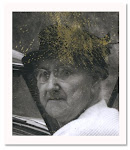This shot comes from an old album I purchased many years ago at an estate sale. The album features the life of a woman who was born in Canada and died in Northern California after a full and rich life.
Click on image to see it larger.
This vintage snapshot, from what I can discern, was taken in Canada. On the side of the truck bed the signage says "Spanish River Pulp" which was the name of a paper company in the town of Espanola in Ontario, Canada.
The Town of Espanola originated as a company-owned town. In 1899 the Ontario government signed the Espanola Agreement with the Spanish River Pulp and Paper Company, which gave the company the authority to begin logging operations over a 5,600 km area for the next 21 years. Under the agreement, a pulp mill capable of employing 250 people was to be constructed. A company-owned town site was established which stretched from the Spanish River to where Second Street is today. (SOURCE: Corporation of the town of Espanola)
To read more about Espanola click here.
It was nice to have this bit of signage because it put the photo in some sort of context. We now know that this man most likely was a driver for the company. Other than that, he'll forever be a mystery.


















For whatever reason I find the old pickup trucks even more interesting than the cars. It must have made a huge difference for companies that previously used horse-drawn carts.
ReplyDeleteThe trucks show purpose and patina from work. They have a life of their own.
ReplyDeleteI love to see an old late '40s to mid-50s pickup driving along the road with a dog sitting happily in the middle of the front seat, a load of something in the truck bed. It hasn't become a collector's item, but is still a functioning truck. So much nicer than a new Ford or Toyota.
Even more interesting than the pickups are the older trucks and delivery vehicles. I can't imagine this one was used to haul pulp - anywhere. Perhaps it was used for local paper delivery, which would be even better, since that paper was probably delivered to a printer. Sooner or later, the paper is turned into letterhead and billhead. That's where I come in. Or at least that's the story I'm reading in this great photograph.
ReplyDelete